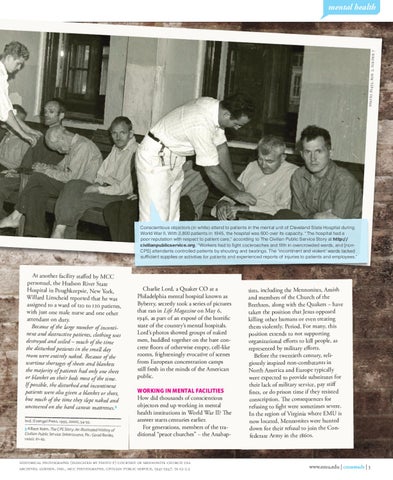Photo #1433, Box 2, Folder
7
mental health
Conscientious objectors (in white) attend to patients in the mental unit of Cleveland State Hospital during World War II. With 2,800 patients in 1945, the hospital was 600 over its capacity. “The hospital had a poor reputation with respect to patient care,” according to The Civilian Public Service Story at http:// civilianpublicservice.org, “Workers had to fight cockroaches and filth in overcrowded wards, and [nonCPS] attendants controlled patients by shouting and beatings. The ‘incontinent and violent’ wards lacked sufficient supplies or activities for patients and experienced reports of injuries to patients and employees.”
At another facility staffed by MCC personnel, the Hudson River State Hospital in Poughkeepsie, New York, Willard Linscheid reported that he was assigned to a ward of 110 to 120 patients, with just one male nurse and one other attendant on duty. Because of the large number of incontinent and destructive patients, clothing was destroyed and soiled – much of the time the disturbed patients in the small day room were entirely naked. Because of the wartime shortages of sheets and blankets the majority of patients had only one sheet or blanket on their beds most of the time. If possible, the disturbed and incontinent patients were also given a blanket or sheet, but much of the time they slept naked and uncovered on the hard canvas mattresses.3 Ind.: Evangel Press, 1995, 2000), 54-55. 3 Albert Keim, The CPS Story: An Illustrated History of Civilian Public Service (Intercourse, Pa.: Good Books, 1990), 61-62.
Charlie Lord, a Quaker CO at a Philadelphia mental hospital known as Byberry, secretly took a series of pictures that ran in Life Magazine on May 6, 1946, as part of an exposé of the horrific state of the country’s mental hospitals. Lord’s photos showed groups of naked men, huddled together on the bare concrete floors of otherwise empty, cell-like rooms, frighteningly evocative of scenes from European concentration camps still fresh in the minds of the American public. WORKING IN MENTAL FACILITIES How did thousands of conscientious objectors end up working in mental health institutions in World War II? The answer starts centuries earlier. For generations, members of the traditional “peace churches” – the Anabap-
Historical photographs (indicated by photo #) courtesy of Mennonite Church USA Archives, Goshen, Ind., MCC Photographs, Civilian Public Service, 1941-1947. IX-13-2.2
tists, including the Mennonites, Amish and members of the Church of the Brethren, along with the Quakers – have taken the position that Jesus opposed killing other humans or even treating them violently. Period. For many, this position extends to not supporting organizational efforts to kill people, as represented by military efforts. Before the twentieth century, religiously inspired non-combatants in North America and Europe typically were expected to provide substitutes for their lack of military service, pay stiff fines, or do prison time if they resisted conscription. The consequences for refusing to fight were sometimes severe. In the region of Virginia where EMU is now located, Mennonites were hunted down for their refusal to join the Confederate Army in the 1860s.
www.emu.edu | crossroads | 3
